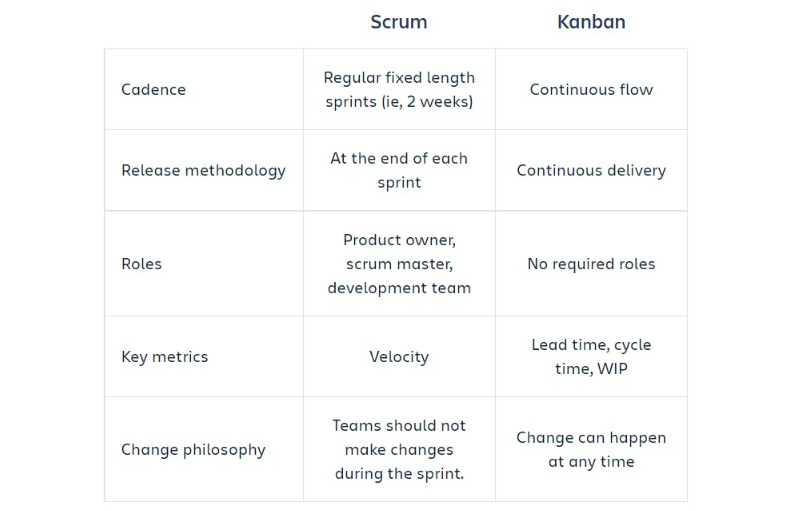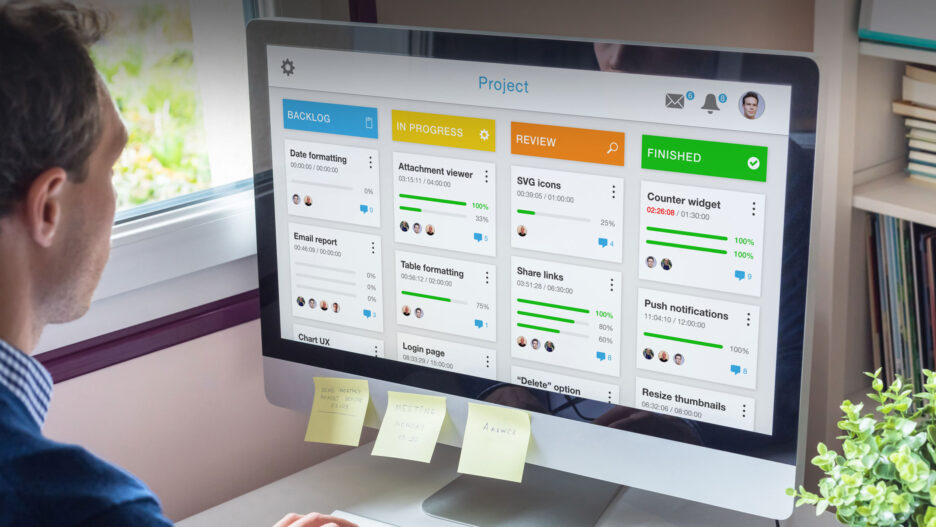Both under the Agile umbrella, Scrum and Kanban are oftentimes used interchangeably by mistake. The confusion is not unwarranted as both frameworks help organize work with one common goal: efficiency.
Nevertheless, there are unique differences that set Scrum and Kanban on opposite spectrums instead of being on the same side of the coin. From team roles, work boards, methodologies, and scheduling cadence, there’s a lot of key traits that can help you identify which is which and when to use one or the other.
In this blog post, we’ll debrief you on:
- what Scrum and Kanban are and their core principles;
- differences and similarities between Scrum vs Kanban;
- when to use Scrum or Kanban.
Put your Agile hat on and let’s get started!
What is a modern software development methodology?
Let’s take a little trip down memory lane, shall we?
Back in 1970, Dr. Winston W. Royce coined the term waterfall as an approach to system analysis, design, and build. Waterfall gained a lot of popularity but system requirements were different back then, so the need for a new, more efficient methodology began to arise as systems began to grow more complex. Circa 2001, Jeff Sutherland and Ken Shwaber introduced the Agile approach in their Agile Manifesto.
Agile development was and is a game-changer for the software development community that allows developers to iterate constantly, in small increments, with shorter feedback cycles, and easy implementation of improvements and fixes. Resources like Scrum and Kanban simplify the implementation of Agile.
Before moving forward, we’ll take two final drives in the DeLorean:
- First, we’ll head all the way back to the early 1940s, where the first Kanban system was put in place by Taiichi Ohno for Toyota in Japan. Built as a simple planning system, Kanban was a way to control and manage work across every stage, looking for optimal results.
- Now, we’ll head to 1986, when Scrum was introduced by Hirotaka Takeuchi and Ikujiro Nonaka in an article named “New New Product Development Game” in the Harvard Business Review. Then, in 1995, Scrum was coined as a formal process by Sutherland and Schwaber at a conference in Austin, Texas.
As you may already know, both frameworks come from a manufacturing background and were later translated to meet the needs of software development.
Scrum vs Kanban
Core principles of Scrum and Kanban
Kanban is a framework that acts as a fantastic work visualizer, aimed at maximizing efficiency. Teams who use Kanban leverage the Kanban board to continuously improve the flow of work.
So, what is the Kanban board? It’s a project management tool that includes five key components:
- Visual signals. Cards with all work items for easy identification.
- Columns. Each column represents a specific task, and when put all together, creates a workflow.
- Work-in-progress limits. Maximum number of cards that can be a part of a column at any given time.
- Commitment point. Based on the board’s backlog, the commitment point marks the time when a client or colleague idea is picked up by the team to begin working on it.
- Delivery point. The end of the Kanban team’s workflow.
Scrum is a lightweight, easy-to-follow framework that is all about sprints where the goal is to create learning cycles to gather feedback quickly and apply it effectively. Scrum teams hold regular ceremonies that are short meetings designed to help teams moving forward quickly, avoiding bottlenecks, and identifying needs in advance.
Now, what is a Scrum board? The Scrum board is basically a Kanban board with Scrum processes, artifacts, and roles. They differ in the fact that Scrum sprints have start and finish dates where Kanban is an ongoing process. Also, while Kanban has no formal roles, Scrum has roles like product owner, the development team, and the Scrum Master.
Another key difference is the Kanban board is used throughout the lifecycle of a project while the Scrum board is erased and started from scratch with every sprint. Kanban has more flexibility with tasks and timing, whereas Scrum boards have a defined number of tasks with more rigid deadlines to meet.
Now, let’s dive right into the similarities and differences of Scrum and Kanban.
Similarities and Differences of Scrum and Kanban
Both Scrum and Kanban enthusiasts can agree on one thing: even though both frameworks provide different methodologies for managing work, the shared principles are largely the same as both will help you build better systems within an Agile framework.
In this table, we’ve summarized what each entail:

And we’ll dissect each one in the next few sections.
Schedule and Cadence in both methods
Scrum is a fast-paced framework that thrives on short, sprint-based periods of time. Thanks to the short time frames, teams are compelled to split tasks into smaller, more manageable stories. Sprints are marked by specific stages like sprint planning, sprint review, and retrospective meetings, sprinkled with daily standup meetings.
Kanban has a continuous structure that helps keep teams flexible and makes it easier to adapt to changing requirements or priorities. Tasks are represented by cards as shown in the Kanban board, where they seamlessly move from one phase to the next. Typically, common stages include To Do, In Progress, In Review, Blocked, and Done. Of course, these are customizable to meet your team’s unique needs.
Release approaches in both methods
How and when are the next versions of the software released in each framework? In Scrum, it’s best practice to deploy a release after each sprint is completed. Thus, the client can see the incremental changes made to the system after each sprint and if necessary, tweak in the next one.
In stark contrast, Kanban-based projects release updates as soon as they’re ready, sans regular or pre-determined deadlines. So, if a task is completed earlier or later, it can be released regardless of other release milestones, like sprint reviews.
Roles in Scrum and Kanban
Who are the folks enacting the practices of both Scrum and Kanban?
Scrum is rooted in the idea of having clearly defined roles that include:
- a product owner in charge of having the client’s best interests front and center, managing the product backlog and prioritizing the development team’s work;
- a Scrum Master who helps the team stay aligned with scrum principles and lead the sprint review meetings;
- the development team who works on the stories incrementally and shows collective accountability.
In Kanban, everyone owns the kanban board and is responsible for the collective results. While some teams draft an Agile coach to have on board, there’s no Master role that owns the process, helping keep things running smoothly. Everyone’s responsibility is to foster collaboration and the delivery of Kanban board tasks.
Key indicators in Scrum and Kanban
Scrum is all about speed, where the key metric to measure is story points as each sprint is completed. By measuring story points from previous sprints, teams can better decide future commitments or determine how much workload can the team undertake in subsequent sprints.
Kanban measures lead time and cycle time which deal with the average time it takes for tasks to move from start to finish. Another key metric worth mentioning is the Work In Progress limits that sets a cap for the number of tasks a team can take in one column.
Attitude towards changes
Scrum teams hold retrospective meetings that help them make changes or adjust user stories. While changes to scope are infrequent, they should be considered when the situation calls for it. Too many changes can expose the software product or service to vulnerabilities and unwanted risks, so teams do their best to avoid scope changes during a sprint.
Kanban enthusiasts are familiar with the continuous stream of changes that get added to the backlog as well as cards that are blocked or entirely removed due to different prioritization needs. For short, Kanban is big on flexibility.
When to use Scrum or Kanban
Since the differences between Scrum or Kanban are somewhat subtle, it’s easy to mix up when one should be used over the other.
As a rule of thumb, Scrum is more advisable to use when tasks are time-sensitive, feature-driven, with major milestones to achieve. Kanban is the favored choice when the task is focused on workflow, handling incoming, relatively small pieces of work, namely defects or small improvement requests.
Some scenarios will warrant the use of a hybrid model where you’ll need to combine specific features of both Scrum and Kanban, leveraging what gives you the most value. In a nutshell, Scrum is a more formal, coherent framework that is not as flexible yet it’s very agile and iterative. On the other hand, Kanban is super flexible and can be thought of as a collection of principles that you can pick and choose from to visualize and improve your work.
Conclusion
Scrum and Kanban are Agile in essence, and share unique principles to optimize processes and deliver high-quality products quickly. More teams are starting to leverage a marriage of Scrum and Kanban features that has been dubbed Scrumban. Scrumban is an agile project management methodology that helps teams work in a Scrum-based framework while leveraging the Kanban board.
Both Scrum and Kanban (and let’s not forget Scrumban!) are valuable solutions that you can engage with confidently, knowing that you’re using progressive, powerful frameworks to boost your projects to a more iterative, scalable, efficient, quality-driven, smart reality.
Svitla System experts are well-versed in everything Agile-related, and Scrum and Kanban are second-nature. If you’re looking to add more agility to your software development projects, look no further and reach out to our Agile experts who are sure to infuse their Agile expertise to your projects as you deem necessary to deliver value.



![[Blog cover] How to build a secure DevOps cycle](https://svitla.com/wp-content/uploads/2025/07/Blog-cover-How-to-build-a-secure-DevOps-cycle-560x310.jpg)

![[Blog cover] Examples of digital transformation in the pharma industry](https://svitla.com/wp-content/uploads/2025/06/Blog-cover-Examples-of-digital-transformation-in-the-pharma-industry-560x310.jpg)